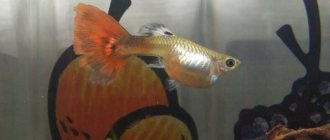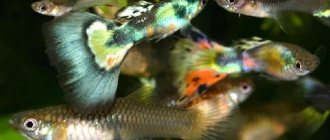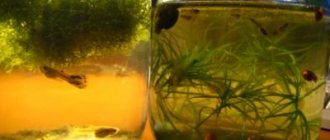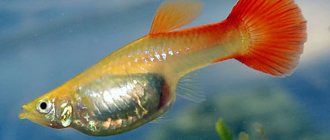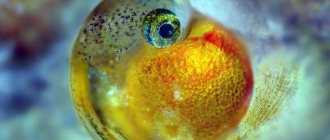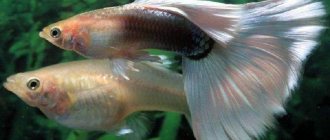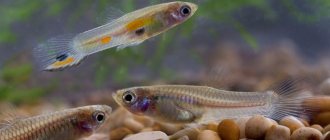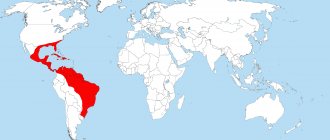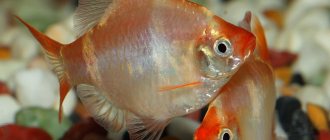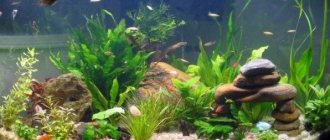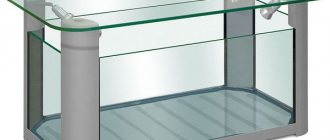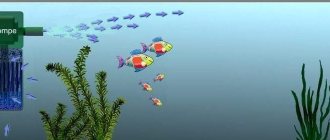Endler's guppies (Latin: poecilia wingei) are one of the smallest inhabitants of domestic ponds, belonging to the Poecilidae, distinguished by their unique appearance and unpretentiousness. The second name is dwarf guppies. This article describes the most popular breeding forms of Endler's guppies, as well as breeding, setting up an aquarium, feeding and other recommendations for keeping these colorful fish.
Habitat in nature
Endler's guppies (species and subspecies) are endemic to the coastal lagoons of De Patos, Campoma and Buena Vista, located in northeastern Venezuela.
History of discovery
The fish were first discovered in 1935 in Laguna de Patos, in northern Venezuela. And the first description in 1937 was made by Franklin F. Bond. The fish, at that time, did not become widespread and were even considered extinct, until scientist John Endler refuted this judgment in 1975.
The species he revived was named Endler's guppy. Now the fish are one of the most popular in ornamental fish farming and have firmly established themselves in home aquariums.
Sexual dimorphism in Endler's guppies
Sexual dimorphism in Endler's guppies , as well as in their closest relatives - reticulated guppies, is pronounced. The length of males usually does not exceed 2.5 cm, while females are almost twice as large. Males have a bright clown outfit, the color of which is dominated by orange, emerald green, red and black. A distinctive feature of the species, in addition to the miniature size of the males, is the presence of a bean-shaped black spot on their body, which in a stressful situation can become almost completely discolored, and when calm comes, restore the original color again.
Endler's guppy - male
The caudal fin in males is usually forked, sometimes only with a lower sword; in the middle part it is transparent, which enhances the impression of a bifurcated tail; its outer rays are brightly colored red or orange with a black edging. In addition to the bright coloring, the male has a modified anal fin - gonopodium.
Females, unlike males, do not have variegated spots; their bodies are uniformly colored gray-yellow with a silver or golden tint.
Endler's guppy - female
Appearance
Mini guppies differ from regular ones in their tiny size. Males grow to only 2.5 cm, females are slightly larger - 3-3.5 cm.
Description and distinctive features:
- the body is flattened laterally, with a smooth transition to the tail;
- the eyes are large (occupy most of the head);
- bright color (multi-colored spots and stripes are randomly scattered throughout the body);
- an oval dark spot on the side, the brightness of which changes depending on the mood of the fish (in babies it appears first, when the color has not yet begun to appear);
- the caudal fin is transparent, but with red, orange or yellow rays along which a dark edge runs.
Life expectancy, with proper care, is 3-5 years.
Sex differences
The female is much larger than the male, a faded solid gold or silver color with a metallic tint. The anal fin is fan-shaped. Males are small, brightly colored, the anal fin-gonopodium (also serves as a fertilization organ) is narrow. It is the bright males that are the real decoration of artificial reservoirs. Male and female Endler's guppy (photo below).
Introduction
Small and incredibly diverse aquarium fish, guppies are known to everyone.
Not long ago, dwarf guppies or Endler's guppies began to appear in home aquariums. These miniature creatures were discovered in the rivers of Venezuela, where they were first observed and described by Franklin F. Bond. Dwarf guppies became known to a wide circle of aquarists after they were once again discovered by John Endler (this happened in 1975). In the literature, dwarf guppies are most often called “Endler’s guppies”. Endler's guppies were first found in Laguna da Patos, which is located in northern Venezuela in 1935. At first, guppies of this species lived in a salty backwater, which was separated from the ocean waters by a narrow strip of land. Over time, numerous precipitations made the water in this lake fresh. At the time of the discovery of this species of fish, the reservoir was filled with algae, with hard water at elevated temperatures. Currently, dwarf guppies are classified as an endangered species.
— Advertising —
The size of Endler's guppies is really very small: males grow no more than 2-2.5 cm, females are slightly longer - 3.5 cm. The body of the fish is slightly elongated and flattened on the sides. The body of females has one color - golden or silver. There is a small dot at the back of the abdomen that indicates the formation and development of embryos. The body of males is brightly colored - specimens are known to be red, orange and purple with bright emerald spots and black bean-shaped markings on the sides. These spots become discolored in case of excitement or stress. The color of the dorsal fin varies from red to shades of blue; there may be spots of various colors on the surface of the fin. The central part of the caudal fin is transparent, the side rays are yellow, orange or red. Sometimes there is a black border along the edge of the side rays of the tail.
Endler's guppies do not live long - only 2-3 years.
Popular types
All of the aquarium fish listed below are selection forms of the same Endler species, but with their own characteristics and distinctive features.
Venezuela
It differs from other species in having a double sword-shaped caudal fin and an elongated dorsal fin resembling a flowing scarf.
Gold
Gold's body is golden in color with randomly scattered red spots. The caudal fin is transparent, with a thin red border at the bottom. This coloring is considered one of the most successful.
Campoma
It has several subspecies: Blue Star, El Tigre, etc., differing from each other only in color.
Cobra
The color of these fish is distinguished by a filigree pattern of many small, irregularly shaped spots, similar to the pattern of snake skin.
Lavender
The coloring of this variety is distinguished by a variety of shades. The predominant color on the sides is lilac, the back is gray, the edging of the tail is red with a thin dark stripe.
Santa Maria
The second name is bleeding heart. The variety was bred by Japanese breeder Kenichiro Tamura. Outside of Japan, the fish is rare.
Peacock
The species is named peacock due to the black spot on the caudal fin. It was discovered and described in 1997 by Adriano Hernandez.
Tiger
Endler's Tiger variety of guppy gets its name from its dark, distinct stripes, reminiscent of a tiger's coat.
Japanese blue
The Japanese guppy has an elegant blue color with a neon shine. There is a dark oval spot on the sides of the body.
Varieties of Endler's guppies
There are several subspecies of Endler's guppies, but they all differ only in their shape and color. As for the conditions of keeping and caring for pets, they are absolutely identical. Varieties:
- brindle
The subspecies got its name due to its characteristic coloring, reminiscent of a tiger skin. On a yellow, orange or golden background there are ornate thin black stripes that form intricate patterns throughout the body. - Blue (Japanese)
It has an amazing turquoise-blue scale color that shimmers in the light with a pearlescent sheen, making the fish appear silvery. Small dark spots may be present on the body and in the head area. - Gold
It is characterized by its bright, sparkling golden color and luxurious veil-shaped tail, which appears completely transparent in the aquatic environment. Red, orange and coral spots are randomly located along the entire body of the fish. - Cobra
One of the rarest and most valuable breeding species of dwarf guppies. Valued by aquarists for its unusual colors, reminiscent of snake skin. - Venezuelan
This fish can have any color, but a characteristic feature of its appearance that distinguishes it from its relatives is the dorsal fin - long and flowing, reminiscent of a chiffon scarf. The tail fin of the Venezuelan guppy is also quite unusual and has the shape of a pointed double sword. - Blonde . The color of this subspecies is dominated by light, pastel colors. The body of the fish can be painted silver, gray, or white. However, the multi-colored spots located along the body and the radiant tint of the scales make the blonde’s appearance bright and unusual.
Experts note that the color intensity of Endler's guppies can vary depending on the parameters of the aquatic environment, health status, diet and care.
Behavior and lifestyle
The fish are peaceful, schooling and very active. Easily adjusted to any acceptable water parameters. A small flock can even be kept in a nano-aquarium.
Compatibility with other types
Endlers are peace-loving. They get along well with small and medium-sized peaceful fish. Intraspecific aggression is also absent. Males never start fights among themselves, and females can show the right to territory, but they do this without malice and, usually, do not cause trouble to other underwater inhabitants.
Suitable neighbors are:
- zebrafish;
- iris;
- tetras;
- mollies;
- swordtails;
- cardinals.
It is not recommended to keep them with ordinary guppies to preserve the purity of the species.
Features of care
One of the reasons for the popularity of these aquarium fish is their easy care. Keeping Endler's guppies is quite possible even for a novice aquarist , these fish are so undemanding. But although they are unpretentious, they feel best if certain rules of care are followed.
Aquarium conditions
Due to the fact that these fish are very small, they do not require much space. For one flock, an aquarium of 50 liters or more is quite suitable. It is advisable that it comes with a lid, since guppies are able to jump out of the container.
Sand or small pebbles are ideal as soil to help the plants gain a foothold. It is advisable to place as many of the latter as the aquarium allows - the fish will be able to hide in their thickets.
Guppies are not very picky about water parameters, but the most suitable parameters for them are:
- temperature is from 22-30 degrees, and it should be taken into account that the higher it is, the faster the fish grow and age;
- hardness - 15−25;
- acidity - from 6.7 to 7.5.
If you are keeping only guppies, the aquarium can be equipped with not too powerful aeration and filtration, but you will have to frequently replace at least a third of the water. But even with more powerful filters in aquariums with mixed content, these fish feel good.
Feed selection
Feeding these fish should not cause any problems, since Endler's guppies are omnivores: they readily eat artificial, live, and frozen food. But we must take into account that their diet must contain food with a high content of plant components, for example, flakes with spirulina. This is necessary to maintain the proper functioning of the fish’s gastrointestinal tract.
Guppies are not picky eaters and eat both live and dry food.
It is also important to take into account the size of guppies: they have a very small mouth, so they are not able to swallow large pieces of food. Frozen food that is crumbled into small pieces or simply crushed is well suited for them: brine shrimp, tubifex, bloodworms or various flakes.
It is worth considering that when overeating, these fish are prone to obesity, so the amount of food given must be carefully monitored. A fasting day once a week will also be useful.
Keeping with other fish
Distinguished by their exceptional friendliness, guppies can boast good compatibility with any small and non-aggressive fish: zebrafish, cardinals, iris, tetras and many others. etc.
Predatory fish, as well as large species characterized by aggressive behavior, will become bad neighbors. It is not advisable to add ordinary guppies to the aquarium: both species will begin to reproduce and give birth to hybrid offspring.
Guppies can get along with small, non-aggressive fish.
Conditions of detention
Guppies are absolutely unpretentious to keep, but it is difficult to care for them correctly.
Choosing an aquarium
It is best to choose a rectangular aquarium with a lid (guppies have high jumping ability) and a built-in lighting lamp.
Volume
The size of the reservoir directly depends on the number of aquarium fish living in it. The larger the volume, the more comfortable underwater inhabitants will feel. One guppy needs at least two liters of water space.
Priming
Coarse sand or small rolled pebbles are suitable as soil. Large stones, artificial caves or grottoes can be used as decoration.
Equipment
Guppies, unlike labyrinth guppies, breathe oxygen dissolved in water, so the presence of a compressor is mandatory. You should also purchase an internal or external (for large volumes) aquarium filter, a thermometer, a heater and a lighting lamp (if it is not built into the aquarium lid).
Plants
Plants are planted in the background and along the side walls so that the fish have enough space to move freely.
It can be:
- hornwort;
- Anubias;
- Vallisneria;
- elodea;
- duckweed;
- various types of mosses;
- cabomba, etc.
The aquarium should be planted densely enough so that kids can hide if the aquarium is shared, and adult fish can rest quietly.
Water parameters
All parameters must be brought to average values.
Optimal requirements:
- temperature - 22-25 ºС;
- pH - 6.7-7.6;
- dH - 4-17.
Fish can easily withstand temperatures up to 30 ºС, but this greatly shortens their lifespan.
Keeping it clean
The cleanliness of the aquarium is maintained by weekly water changes (20% of the volume) and cleaning the soil with a siphon. And also be sure to install an internal filter and compressor.
Cleaning the soil from dirt and excrement using a siphon is carried out once a week
Care and maintenance of small fish
These are unpretentious inhabitants of the aquarium, but they also require good living conditions for full life and reproduction. The water temperature should be 28-30 degrees, but they can live in colder temperatures, up to 18 degrees. It is important to remember that the warmer it is in the aquarium, the more active the fish are, but their life expectancy will be shorter.
Endler's fish love slightly salted water, like other representatives of poeciliids. To do this, use edible sea or rock salt. This should only be done if there are no other fish in the aquarium. Add salt at the rate of 1 tablespoon for every 10 liters of water.
Provide the aquarium with a sufficient amount of shelter, for example, plant algae.
When filtering and aerating water, you should avoid the formation of a strong current, because the fish are small and will simply be carried away.
It is good to change the water with a fresh portion once a week. In this case, a third of the volume of the aquarium is replaced.
We recommend reading
What to feed catfish in an aquarium
The container must have a lid. In order for the flock to exist peacefully, it is better to choose an aquarium of at least 50 liters. Multi-colored pets look more expressive if you use dark soil in the aquarium.
Feeding
Under natural conditions, dwarf guppies feed on small insects and algae; in an aquarium they consume any type of small food. You should definitely feed your pets cereal with spirulina or other greens. Adults eat once a day
The diet consists of:
- bloodworms (frozen or live);
- tubifex;
- Artemia;
- Daphnia;
- Cyclops.
It is important not to overfeed, as guppies have a tendency to become obese. Once a week it is recommended to arrange a fasting day for them.
Feeding the fry
Babies eat the same food as adults, but they should be fed much more often. Until the fry are one month old, food is given three times a day.
Maintenance and care
Among all existing ornamental fish, dwarf guppies are one of the most resilient and unpretentious species. To ensure comfortable conditions for them, you will need to make a minimum of effort.
The aquarist will need:
- Buy an aquarium . It is chosen on the basis that half a liter of water is required for each male, and a liter for the female.
- Provide easy filtration and aeration. To do this, you will need to purchase a filter device with an air pumping function.
- Provide natural hiding places for the guppies. This becomes especially relevant if you plan to breed them. To do this, plants such as water wisteria, Java fern, hornwort, Hygrophila polysperma, Vallisneria, Elodea canadensis, and duckweed are planted in the aquarium. Dense thickets of Java moss will be a good refuge for fry.
- Install a lighting system. The light should be bright, with an intensity of about 0.4 W/l. Daylight hours are 9-10 hours a day. Longer illumination leads to infertility of females and changes in the color saturation of males.
It is recommended to use river sand with a fraction of 2-3 mm or small pebbles with a size of 2-8 mm as soil. Laying layer 4-5 cm.
The water that is poured into the aquarium must meet the following requirements:
- Have a temperature of 22-25°C. When water is heated above 25 degrees, the guppies' metabolic processes will proceed faster and their lifespan will decrease.
- The hardness index should be from 7-20 units , the acidity level should be in the range from 6.9 to 9.0.
Partial water changes in the amount of 25-30% of the total fluid volume are carried out every week.
Reproduction
Endlers reproduce well in a community aquarium, provided that ordinary guppies do not live next to them. To maintain the purity of both breeds, reproduction occurs in a spawning tank.
Favorable conditions
If the common reservoir has good filtration, aeration and a lot of plants, future parents will not need human help.
To create favorable conditions for a pregnant fish, you need a little:
- Correctly determine the gestational age and readiness of the fish for childbirth.
- Set up a fish tank in advance and transplant the expectant mother into it.
- Do not disturb the pet just before birth.
Features (write about live birth)
The Endler female, like all livebearers, is capable of producing offspring already prepared for independent life with a frequency of 22-24 days. Unlike other fish, mother guppy rarely eats her children. but this can happen. Therefore, when the birth process is over, the female is transplanted into a common aquarium.
Determination of gestational age
Beginning aquarists need to learn how to determine the stage of pregnancy and readiness for childbirth. The accuracy should be maximum - 1-2 days.
Signs of pregnancy to look out for:
- A dark spot appears in the back of the abdomen (next to the anal fin).
- In most species of guppies, the abdomen of the pregnant female becomes almost square.
- Swelling near the anus is the main sign of impending labor.
This is done in order to place the female in advance in a prepared spawning tank so that she gets used to the new environment and does not experience stress. Only in this case will the offspring be born healthy and active.
Below is a photo of a guppy in the last stage of pregnancy.
Preparing the depositor
Childbirth is an important process that requires the attention of the fish farmer. Therefore, the arrangement of the sedimentation tank must be taken responsibly.
The requirements are as follows:
- The volume of the aquarium is 12-30 liters.
- No soil required. This is important for maintaining cleanliness.
- The internal filter and compressor must operate around the clock.
- There should be no strong current in the reservoir.
- The presence of plants and moss is mandatory for the comfort of children.
The container is prepared in advance so that biological equilibrium is established.
Childbirth
When optimal conditions are created, the female produces up to 30 fry. If the female cannot give birth, labor is stimulated by placing a male next to the expectant mother, as well as increasing the temperature in the nursery by 2-3 ºС and adding fresh water to it.
Nursing babies
The fry that are born are quite large and can immediately feed on small dry food and Artemia nauplii. With regular meals three times a day, they grow quickly and at the age of one month the males are fully colored and ready to breed.
Breeding and reproduction
Endler's guppies reproduce well in artificial habitats. However, to obtain good offspring, you need to create optimal conditions for this.
Preparing for spawning . It is necessary to prepare in advance a separate aquarium - a spawning tank, designed for a couple of fish, and select the healthiest, most beautiful representatives of both sexes. In the spawning tank, to achieve the most positive results, it is recommended:
- maintain the temperature within +20 – +25°C;
- decorate the pond with greenery;
- carry out partial water changes regularly.
All this has a positive effect on fish fertility and spawning success.
Spawning . The spawning process looks beautiful and exciting. Males court females, showing increased activity, organizing courtship dances, showing off their luxurious fan-shaped tail. Over the course of several days, the female lays eggs - from 5 to 25 eggs.
The fry are born after 24 days.
Despite the fact that Endler's guppies do not have a tendency to eat their own offspring, it is still better to move them into a common aquarium, since these fish are deprived of parental instincts and will not care for the fry.
Caring for offspring . The fry are born quite large, and therefore aquarists do not have any special problems with caring for them. You can feed babies with brine shrimp, “live dust”, small cyclops, and specialized dry food intended for fry.
The fry should be given food 3 times a day, trying to maintain time intervals between feedings. The fry reach sexual maturity at the age of 3 months, after which they can be safely moved from the spawning tank to a general aquarium.
Diseases and their treatment
Endler's guppies have good immunity and, with proper care, are not susceptible to diseases, but you should be aware that sudden temperature changes can worsen the condition of the fish.
Diseases can also be caused by injury or prolonged exposure to an unsuitable environment.
Symptoms:
- lethargy;
- refusal to eat;
- body deformation.
First of all, it is recommended to check the basic indicators of water (hardness and acidity) and the presence of nitrogen concentration. Restoring biological balance usually leads to an improvement in the pet's condition. However, if symptoms persist for more than 2-3 days, drug treatment will be required.
Compatibility with other types
Endler's guppies are distinguished by their calm and peaceful disposition. Even during the spawning period, they do not show aggression towards their relatives or other aquarium inhabitants. Ideal neighbors for dwarf guppies would be:
- platies;
- neons;
- other varieties of guppies;
- iris;
- zebrafish;
- speckled catfish;
- rasboras;
- mollies;
- cardinals.
It is strictly contraindicated to house Endler's guppies in the same artificial reservoir with large, predatory and aggressive fish, such as:
- barbs;
- piranha;
- angelfish;
- discus;
- goldfish;
- astronotuses.
Any predatory fish will view the little Endler's guppy as potential prey, which is important to consider when choosing a neighborhood.
Interesting Facts
Cheerful, brightly colored fish not only decorate home ponds.
Few people know that:
- a female Endler's guppy is able to retain the sperm of a male in her body for about three months, and accordingly, she can give birth to fry without a male several times, and she can easily do this even in a glass of water;
- each male guppy has a unique coloring that is not repeated twice;
- the guppy was the first fish to travel into space on board the Salyut 5 orbital station;
- It’s hard to believe, but in the 19th century, wild guppies saved the local population from the spread of malaria by eating eggs, larvae and pupae of malaria mosquitoes;
- These miniature fish are also tested for the degree of wastewater treatment, the effects of chemicals and heavy metals.
Content Features
Endler's guppy is a hereditary fish, that is, it reproduces by leaps and bounds. Because of this ability, breeders managed to create so many variations of the animal. The range of colors and body ornaments knows no bounds. That is why, when choosing a fish, you can find exactly what you need.
It has an oblong body in shape. But how long do these fish live? In aquarium conditions, this breed can live for about a year. But there have been cases when a guppy lived in such conditions for more than 2.5 years. The main characteristic that affects its lifespan is temperature. Remember, metabolic rate directly depends on temperature, as does lifespan. For example, high indicators can only speed up such processes. Therefore, an aquarium fish may die prematurely.
Keeping Endler's guppies in an aquarium
To keep Endler's guppies , a small aquarium with a volume of 40 liters or more is sufficient. In principle, they can be content with a much smaller tank size, but taking into account group keeping and the prospect of reproduction, it is better to adhere to the original recommendation.
The aquarium must be planted with small-leaved plants, leaving areas for free swimming, and a small amount of floating flora should be placed on the surface of the water.
To maintain cleanliness, a small, low-power internal filter that does not create strong water movement is sufficient.
Recommended hydrochemical parameters of water are as follows: temperature 24 – 30 °C, pH: 7.0 – 8.5, total hardness 15 – 35dGH.
Due to their small size and other biological characteristics, I would not recommend keeping Endler's guppies in a mixed aquarium, especially if they are planned to be bred in the future. If this is unavoidable, peaceful small fish species can be recommended as neighbors, for example, dwarf corydoras, tetras and rainbowfish (Iratherina werneri, Pseudomugil).
You should not keep Endler's guppies with reticulated guppies, as this will inevitably lead to interspecific crossing and the appearance of hybrids.
When kept in an aquarium, male Endler's guppies do not exhibit intraspecific aggression, while females often demonstrate their territoriality. In this regard, it is better to keep fish in a fairly large group, then the aggression of females will come to naught.
Endler's guppies often jump out of the water, so the aquarium with them must be covered.
In an aquarium, the lifespan of fish is 2-3 years (depending on temperature), females live a year and a half longer than males.
